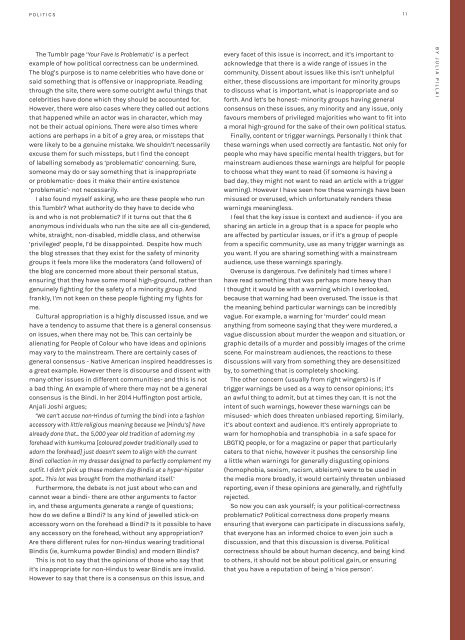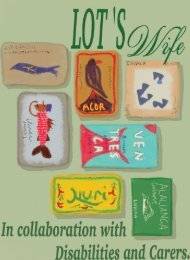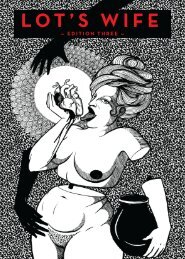Lot's Wife Edition 6 2015
Create successful ePaper yourself
Turn your PDF publications into a flip-book with our unique Google optimized e-Paper software.
POLITICS 11<br />
The Tumblr page ‘Your Fave Is Problematic’ is a perfect<br />
example of how political correctness can be undermined.<br />
The blog’s purpose is to name celebrities who have done or<br />
said something that is offensive or inappropriate. Reading<br />
through the site, there were some outright awful things that<br />
celebrities have done which they should be accounted for.<br />
However, there were also cases where they called out actions<br />
that happened while an actor was in character, which may<br />
not be their actual opinions. There were also times where<br />
actions are perhaps in a bit of a grey area, or missteps that<br />
were likely to be a genuine mistake. We shouldn’t necessarily<br />
excuse them for such missteps, but I find the concept<br />
of labelling somebody as ‘problematic’ concerning. Sure,<br />
someone may do or say something that is inappropriate<br />
or problematic- does it make their entire existence<br />
‘problematic’- not necessarily.<br />
I also found myself asking, who are these people who run<br />
this Tumblr? What authority do they have to decide who<br />
is and who is not problematic? If it turns out that the 6<br />
anonymous individuals who run the site are all cis-gendered,<br />
white, straight, non-disabled, middle class, and otherwise<br />
‘privileged’ people, I’d be disappointed. Despite how much<br />
the blog stresses that they exist for the safety of minority<br />
groups it feels more like the moderators (and followers) of<br />
the blog are concerned more about their personal status,<br />
ensuring that they have some moral high-ground, rather than<br />
genuinely fighting for the safety of a minority group. And<br />
frankly, I’m not keen on these people fighting my fights for<br />
me.<br />
Cultural appropriation is a highly discussed issue, and we<br />
have a tendency to assume that there is a general consensus<br />
on issues, when there may not be. This can certainly be<br />
alienating for People of Colour who have ideas and opinions<br />
may vary to the mainstream. There are certainly cases of<br />
general consensus - Native American inspired headdresses is<br />
a great example. However there is discourse and dissent with<br />
many other issues in different communities- and this is not<br />
a bad thing. An example of where there may not be a general<br />
consensus is the Bindi. In her 2014 Huffington post article,<br />
Anjali Joshi argues;<br />
‘We can’t accuse non-Hindus of turning the bindi into a fashion<br />
accessory with little religious meaning because we [Hindu’s] have<br />
already done that... the 5,000 year old tradition of adorning my<br />
forehead with kumkuma [coloured powder traditionally used to<br />
adorn the forehead] just doesn’t seem to align with the current<br />
Bindi collection in my dresser designed to perfectly complement my<br />
outfit. I didn’t pick up these modern day Bindis at a hyper-hipster<br />
spot... This lot was brought from the motherland itself.’<br />
Furthermore, the debate is not just about who can and<br />
cannot wear a bindi- there are other arguments to factor<br />
in, and these arguments generate a range of questions;<br />
how do we define a Bindi? Is any kind of jewelled stick-on<br />
accessory worn on the forehead a Bindi? Is it possible to have<br />
any accessory on the forehead, without any appropriation?<br />
Are there different rules for non-Hindus wearing traditional<br />
Bindis (ie, kumkuma powder Bindis) and modern Bindis?<br />
This is not to say that the opinions of those who say that<br />
it’s inappropriate for non-Hindus to wear Bindis are invalid.<br />
However to say that there is a consensus on this issue, and<br />
every facet of this issue is incorrect, and it’s important to<br />
acknowledge that there is a wide range of issues in the<br />
community. Dissent about issues like this isn’t unhelpful<br />
either, these discussions are important for minority groups<br />
to discuss what is important, what is inappropriate and so<br />
forth. And let’s be honest- minority groups having general<br />
consensus on these issues, any minority and any issue, only<br />
favours members of privileged majorities who want to fit into<br />
a moral high-ground for the sake of their own political status.<br />
Finally, content or trigger warnings. Personally I think that<br />
these warnings when used correctly are fantastic. Not only for<br />
people who may have specific mental health triggers, but for<br />
mainstream audiences these warnings are helpful for people<br />
to choose what they want to read (if someone is having a<br />
bad day, they might not want to read an article with a trigger<br />
warning). However I have seen how these warnings have been<br />
misused or overused, which unfortunately renders these<br />
warnings meaningless.<br />
I feel that the key issue is context and audience- if you are<br />
sharing an article in a group that is a space for people who<br />
are affected by particular issues, or if it’s a group of people<br />
from a specific community, use as many trigger warnings as<br />
you want. If you are sharing something with a mainstream<br />
audience, use these warnings sparingly.<br />
Overuse is dangerous. I’ve definitely had times where I<br />
have read something that was perhaps more heavy than<br />
I thought it would be with a warning which I overlooked,<br />
because that warning had been overused. The issue is that<br />
the meaning behind particular warnings can be incredibly<br />
vague. For example, a warning for ‘murder’ could mean<br />
anything from someone saying that they were murdered, a<br />
vague discussion about murder the weapon and situation, or<br />
graphic details of a murder and possibly images of the crime<br />
scene. For mainstream audiences, the reactions to these<br />
discussions will vary from something they are desensitized<br />
by, to something that is completely shocking.<br />
The other concern (usually from right wingers) is if<br />
trigger warnings be used as a way to censor opinions; it’s<br />
an awful thing to admit, but at times they can. It is not the<br />
intent of such warnings, however these warnings can be<br />
misused- which does threaten unbiased reporting. Similarly,<br />
it’s about context and audience. It’s entirely appropriate to<br />
warn for homophobia and transphobia in a safe space for<br />
LBGTIQ people, or for a magazine or paper that particularly<br />
caters to that niche, however it pushes the censorship line<br />
a little when warnings for generally disgusting opinions<br />
(homophobia, sexism, racism, ableism) were to be used in<br />
the media more broadly, it would certainly threaten unbiased<br />
reporting, even if these opinions are generally, and rightfully<br />
rejected.<br />
So now you can ask yourself; is your political-correctness<br />
problematic? Political correctness done properly means<br />
ensuring that everyone can participate in discussions safely,<br />
that everyone has an informed choice to even join such a<br />
discussion, and that this discussion is diverse. Political<br />
correctness should be about human decency, and being kind<br />
to others, it should not be about political gain, or ensuring<br />
that you have a reputation of being a ‘nice person’.<br />
BY JULIA PILLAI

















